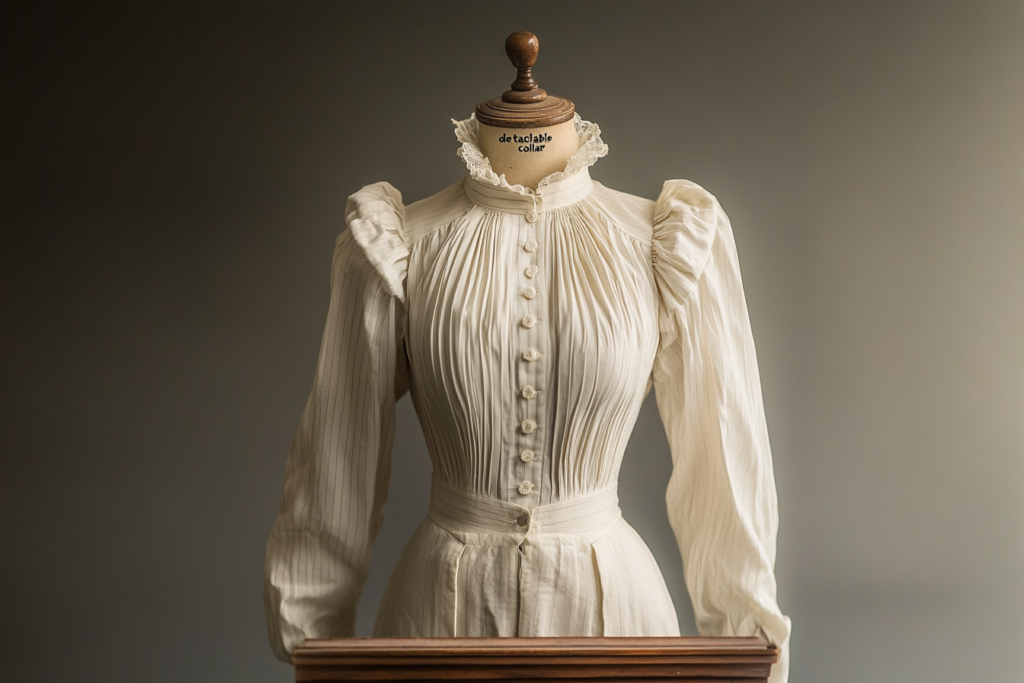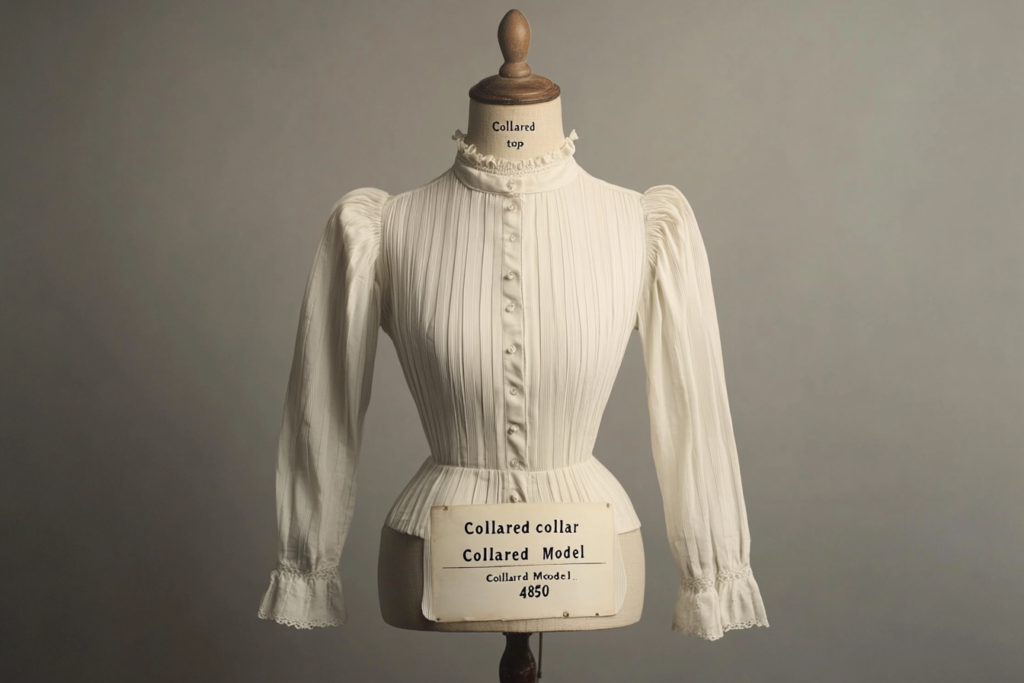Shirtwaist: A Timeless Classic in Women’s Fashion
Meta Description: The shirtwaist is a structured, suit-style shirt with a collar, cuffs, front placket, and waistband, typically made from woven fabric. Learn about its history, key features, and how to style it.
What is a Shirtwaist?
A shirtwaist is a classic women’s shirt inspired by men’s suit-style dress shirts. It features a structured collar, cuffs, a front placket, and typically includes a waistband that enhances the shape. Traditionally made from woven fabrics such as cotton or linen, the shirtwaist has evolved into an essential wardrobe piece, offering a balance of elegance and practicality.
Originally popularized in the late 19th and early 20th centuries, the shirtwaist was a symbol of women’s independence and professionalism. Over time, it has remained a staple in women’s fashion, transitioning from a formal office look to a versatile garment that suits both casual and formal settings.


Key Features of a Shirtwaist
✔ Suit-Style Collar – The shirtwaist features a structured collar, often similar to men’s dress shirts.
✔ Cuffed Sleeves – Includes buttoned cuffs, adding to its polished and tailored appearance.
✔ Front Placket – The shirt has a buttoned front placket, which contributes to its structured look.
✔ Waistband Detail – Unlike traditional shirts, a shirtwaist is cinched at the waist, enhancing the wearer’s silhouette.
✔ Woven Fabric Construction – Typically made from cotton, linen, poplin, or other woven materials, ensuring durability and a crisp finish.
✔ Versatile Styling – Can be worn tucked in, belted, or layered, making it a perfect blend of formal and casual fashion.
The History of the Shirtwaist
The shirtwaist gained popularity in the 1890s and early 1900s as women entered the workforce and sought practical, stylish clothing. It became the go-to outfit for office workers, teachers, and independent women, often paired with a long skirt for a smart, professional look.
During the early 20th century, the Gibson Girl look—defined by a fitted shirtwaist and voluminous skirt—dominated fashion. The shirtwaist was celebrated for its functionality and elegance, making it one of the first widely adopted ready-to-wear garments for women.
Over the years, designers have adapted the shirtwaist into different styles, including shirtwaist dresses, which combine the button-down top with a flowing skirt, creating a timeless, feminine silhouette.
Why Wear a Shirtwaist?
📌 Classic and Elegant Look – The structured collar, cuffs, and waistband provide a refined yet approachable style.
📌 Workwear Essential – Perfect for office settings, the shirtwaist maintains a professional and polished appearance.
📌 Flattering Fit – The waistband design enhances the natural waistline, creating a feminine yet tailored look.
📌 Versatile Styling Options – Can be dressed up or down, making it suitable for casual, business, and semi-formal occasions.
📌 Timeless Fashion Piece – Unlike trend-driven clothing, the shirtwaist remains a fashion staple through the decades.
How to Style a Shirtwaist
1️⃣ Office Chic – Pair a white shirtwaist with tailored trousers and pumps for a sophisticated, professional look.
2️⃣ Casual Everyday – Wear a lightweight cotton or linen shirtwaist with jeans and sneakers for a relaxed, stylish outfit.
3️⃣ Vintage-Inspired – Combine a fitted shirtwaist with a high-waisted, A-line skirt and heels for a classic 1950s-inspired look.
4️⃣ Belted Dress Look – Choose a shirtwaist dress, cinch it with a belt, and pair it with boots or sandals for an effortless day-to-night outfit.
5️⃣ Layered for Fall & Winter – Wear a long-sleeve shirtwaist under a trench coat, paired with knee-high boots for a polished autumn ensemble.
Shirtwaist vs. Traditional Dress Shirt
| Feature | Shirtwaist | Traditional Dress Shirt |
|---|---|---|
| Waist Design | Fitted at the waist, often with a waistband or belt. | Straight-cut with no waist emphasis. |
| Length | Often slightly longer, designed to be tucked or belted. | Standard shirt length. |
| Fabric | Woven fabrics like cotton, linen, or poplin. | Can include woven and blended fabrics. |
| Style Use | Versatile – casual, business, or formal. | Primarily business or formal wear. |
Advantages & Disadvantages of a Shirtwaist
| Pros | Cons |
|---|---|
| Timeless Elegance – A sophisticated, structured look that never goes out of style. | Requires Ironing – Woven fabrics may wrinkle easily. |
| Flattering Silhouette – The cinched waist enhances the figure. | Limited Stretch – Unlike knit fabrics, woven materials offer less flexibility. |
| Versatile for All Occasions – Can be worn formally or casually. | May Require Tailoring – Some styles need adjustments for the perfect fit. |
| Classic Workwear Staple – Ideal for office and business casual settings. | Not Ideal for Relaxed Fits – For those who prefer oversized or loose styles, this may feel too structured. |
Modern Variations of the Shirtwaist
📌 Shirtwaist Dress – A button-down dress that maintains the structured elements of a shirtwaist but extends into a skirt, creating a feminine and comfortable silhouette.
📌 Short-Sleeve Shirtwaist – A more relaxed version, perfect for warmer weather, often made from breathable fabrics like linen.
📌 Belted Shirtwaist – A modern take that includes a fabric or leather belt for a more defined waist.
📌 Casual Shirtwaist Blouse – A lightweight variation that pairs well with denim for a casual but polished appearance.
Conclusion: The Enduring Appeal of the Shirtwaist
The shirtwaist is a timeless, structured garment that has remained relevant for over a century. Originally a symbol of women’s independence and professionalism, it continues to be a wardrobe staple due to its versatility, elegance, and flattering fit.
Whether you prefer the classic button-down look or a modern shirtwaist dress, this iconic style is perfect for both work and casual wear. With endless styling possibilities, the shirtwaist remains a must-have for any fashion-conscious individual.



